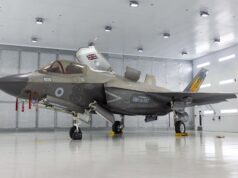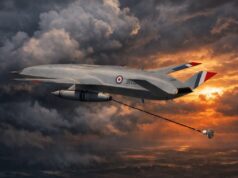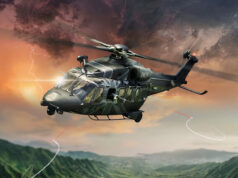The UK is re-establishing its long-range MPA capability with the purchase of nine Boeing P-8A Poseidon aircraft from the United States.
The Defence Committee advises that it had received detailed written evidence from former RAF officers with extensive experience of ASW operations who argue that “the intended aircraft and crew provision for the MPA force is too low to fulfil the range of tasks under its responsibility.”
The report adds:
“Unrealistic assumptions have been made about the ability of NATO allies to contribute to MPA provision and that at least 16 aircraft and a higher crewing requirement is needed to attain the necessary coverage.”
Recently, James Gray, Conservative Member of Parliament for North Wiltshire, outlined his concerns at the proposed number of P-8 Maritime Patrol Aircraft the UK is to purchase.
We’re willing to believe he misspoke as the UK currently plans to purchase nine P-8 Poseidon aircraft, not eight. Gray said in response to a question regarding his level of concern at the cuts the Minsitry of Defence is facing:
“More than anything else, the thinking about the possibility of a cold-weather threat is something that we have had and have contributed to NATO for 40 years. This year, at least, we are downgrading it. I am told that the MOD are going to bring it back up again the following year, but I will believe that when I see it, quite frankly. I very much hope they will.
The same applies to maritime patrol aircraft, which are terribly important in all this. All right, we are getting them but only eight —the P-8s. Will they be enough really to monitor what is happening with Russian submarine activity in the North Atlantic?
Our under-ice capability previously was largely to monitor Russian SSBN activity out of Murmansk and elsewhere along the Arctic coast. Without that capability and regular patrols under the ice in the north, do we really know what the Russians are doing with their submarines? Are we allowing the bastion concept, which stretches on the map at least theoretically as far as the Shetland Islands—are we really able to check what is happening there?
I think we risk reducing our capability in the High North. Generals always fight the last war. Everyone is very fussed at the moment about terrorism, counter-insurgency, Syria, Iraq and all that, and quite rightly should be. I’m not knocking that. I just wonder whether we should start to focus our attention back to where the next war will be, or the next area of tension might be, namely the North Atlantic.”
The Ministry of Defence’s Modernising Defence Programme (MDP) must address the challenges presented by the resurgence of state-based threats and be supported by a fully-funded and sustainable financial settlement, says a report published by the Defence Committee. The report, entitled Beyond 2 per cent, has been produced ahead of the anticipated release of ‘high-level findings’ by the MDP, towards the end of June. It examines how the process has proceeded and highlights areas, including capability, commercial practices, recruitment and international partnerships, which the Committee expects the review to consider.
Dr Julian Lewis, Defence Committee chairman, said:
“We hope that our report will assist in sparking debate and focusing minds on priorities that should be considered by the Modernising Defence Programme. The Secretary of State was right to remove Defence from the National Security Capability Review which would otherwise have resulted in further disastrous cuts to the Armed Forces, and we endorse his efforts to obtain a better settlement for Defence.
The Government now needs to look beyond the two per cent minimum on Defence spending, and begin moving towards a figure of three per cent, to place our defence policy on a sustainable basis to meet new threats and fill existing financial ‘black holes’. Defence is constantly described as the first duty of government. The MDP is the government’s opportunity to show that it means what it says.”
The P-8 Poseidon, developed by Boeing, is designed to conduct anti-submarine warfare (ASW), anti-surface warfare (ASUW), and shipping interdiction, along with an electronic signals intelligence (ELINT) role. This involves carrying torpedoes, anti-ship missiles and other weapons.
The history of the aircraft dates back to June 2004, when the US Navy announced the selection of the Boeing multimission maritime aircraft, 737 MMA, and awarded a contract to Boeing for the system development and demonstration phase of the programme for the US Navy’s next-generation maritime surveillance aircraft. The aircraft was given the designation P-8A in March 2005.
It also has coastal surveillance capability. The P-8 is fitted with advanced magnetic anomaly detection system for submarine tracking. The Poseidon can be used for search and rescue operations.
According to the US Navy, the aircraft in US service carries lightweight Raytheon Mk54 anti-submarine torpedoes. It may also carry other torpedoes, missiles, free-fall bombs, depth charges, mines, or sonbuoys in its weapon bay. Air-to-surface and air-to air missiles, such as Harpoon anti-ship missiles, SLAM or AGM-65 Maverick land attack missiles, and AIM-9 Sidewinders or AIM-120 AMRAAMs will be carried on the underwing hardpoints.
P-8 Poseidon Quick Facts, courtesy of Boeing
- For the P-8, Boeing uses a first-in-industry in-line production system that leverages the best of Boeing Commercial and Boeing Defense for development and production.
- The P-8 can fly up to 41,000 feet and travel up to 490 knots.
- P-8 offers higher reliability – the 737 has a 99.8 percent dispatch rate, with more than 4,000 aircraft flying, and 6,600+ orders.
- The P-8 is engineered for 25 years/25,000 hours in the harshest maritime flight regimes, including extended operations in icing environments.
- The P-8 can fly in all flight regimes, and can self-deploy up to 4,500 miles from base without refueling.
- Dual CFM-56B commercial engines each provide 27,000 pounds of thrust, greatly enhancing climb and flight characteristics over turboprop equipped aircraft.
- Each engine is equipped with a 180KVA engine driven generator. Combined with the 90KVA commercial APU, this provides 450KVA of power. P-8 possesses significant growth capacity for equipment with excess onboard power and cooling capacity.
- P-8 has twice the sonobuoy processing capability and can carry 30 percent more sonobuoys than any maritime patrol and reconnaissance aircraft currently flying.
- P-8 has the ability to control unmanned air vehicles (level 2 control-receive) to extend sensor reach.
- P-8 offers commonality with 737 fleet and other military platforms that use the 737 airframe.
The aircraft are to be based at RAF Lossiemouth in Scotland and be used to protect the UK’s nuclear deterrent and new aircraft carriers. The P-8s are also to perform search-and-rescue missions and conduct overland reconnaissance.














9 aircraft is not enough. The RAF have said they need another 6-9 more to provide a decent level of capability and availability.
This is a classic UK armed forces procurement issue exquisite kit, just not enough of it.
i’d prefer them to be configured for warfare with an anti submarine capability.working in tandem with a Poseidon.
For what it is worth, I think the MoD should order additional maritime patrol aircraft from the Japanese. I believe the Kawasaki P1 airframe is the superior to the Boeing 737 in the Anti-Sub and maritime patrol role. Also I think the Kawasaki P1 airframe lends itself to being modified for the next generation AWACS aircraft for the RAF.
I believe the plan was always to supliment out new MPA with UAV’s specifically the Triton.
See the article from UKDJ that even suggests this: –
https://ukdefencejournal.org.uk/mq-4c-triton-demonstrates-link-capabilities-p-8/
I believe the original plan was to supliment our MPA with a UAV like the Triton.
This was suggested back on the 23/06/16 on UKDJ “MQ-4C Triton demonstrates link capabilities with P-8”
Although more air frames would be nice but I just cannot see it happening. Maybe a second batch in 10+ years after the first 9 have been bedded in, but otherwise we just have too many gaps elsewhere and too little money, even if we do get an increase.
Following TM’s NHS announcement it is quite clear that tax rises are needed to pay for it. Can you imagine the electorate backing the same plan for defence? Before we throw more money at the problem we need to examine why we get so little for our current budget, then and only then should we increase spending. Otherwise it just gets lost in the same endless process of MOD, BAE et al quibbles and rethinks.
Would be nice to have an edit function!
Yes, both for comments on this site and for government defence policy 🙂
16 airframes and the relevant number of crews seems like a sensible number, especially considering the resurgance of the Russian bear!
“Before we throw more money at the problem we need to examine why we get so little for our current budget”
Exactly. It’s too late now to worry about the carriers – which the UK simply does not need – but it’s that sort of feckless expenditure that has had a negative effect on the rest of the budget.
Does the UK need Joint Force Command – another 4 Star HQ and subordinate staffs and all the expense it entails?
Is the British Army too large? Another reduction in manpower would be logical to release funds.
You think 80k is too large? It should be back at pre 2010 levels!
The army is already to small given the presumed and possible threats going forward.
We can argue about the regular and reserve split, but numbers are to low.
‘Is the British Army too large? Another reduction in manpower would be logical to release funds’
It’s hardly an army any more, after all the cuts.
We don’t the money to procure and crew 16 P8 aircraft.
Lucky to get 9, there was talk of only 5 aircraft at one stage.
If your going to have a wish list of equipment purchases then you better tell how your going to pay for it and the people to.man it.
That’s simple Mike, proper funding to procure man and maintain the equipment across the services.
All that’s lacking is the will to do this from our lack luster political parties.
They would rather spend money on any ‘snow flake ’cause that gets them re elected … Anything but defence..
Easy. Take the ‘Continuous At-Sea Nuclear Deterrent’ out of the Defence budget – as it was before.
2% plus CASND expenditure. Pay the Defence for the sailors crewing the CASND.
Where is the money going to.come from to pay for trident?
Unless you propose scrapping it.
It would come from the national budget. The SSBNs are not a naval asset and should not be charged against the RN.
Even 16 is not enough to do a 24/7/365 ASW patrol and if it was the fuel cost at 20 tons per 4 hours on station is going to be over 40,000 tons a year.
Forget the lot and buy 4 more Astutes instead which can do 24/7/365 and go under ice and not litter the ocean with sonobuoys and so on.
It would be useful to understand what the “unrealistic assumptions” were regarding Nato allies. The UK will have 9x P8’s, Norway will have 5x replacing their 6x Orions. Assuming the UK’s maritime upgrade was implemented for Sentinel then we have another 4x “low end” maritime patrol aircraft while we wait for the P8’s. France plans to be flying 18x updated Breguet Atlantic into the 2030’s. Germany, Spain, Portugal have 17x Orions of various vintages between them although one feels the need to always add a caveat nowadays with a question about how many of the German aircraft may be airworthy.
So I’m sure the capabilities vary from state of the art on down but once again not a disaster just not ideal and I’m not including any US or Canadian capabilities reaching out from that side of the pond.
I would rather cut the MPA than the army.
Any realistic way situation we are likely to face involves a conflict overseas and unless the plan is to just chuck some bombs at them and done, then boots on the ground are needed to actually win the conflict. There seems to be a big question of how mant fighting soldiers we can deploy for any length of time currently, further cuts would not help with that.
The actual fighting strength of the army is less than 60000.
This number is derived by excluding those medically unfit, in training and a variety of other reasons.
Then add to that those in logistic, command and other non combat duties you have less than 30000 actual troops to do the fighting ( infantry, armour, artillery, engineers and air corps). Infantry strength is around 15000, then you have to rotate those when in combat. On a sustainable basis you can only deploy 7500 infantry at one time to meet all defence needs across the globe. Of course in a short term emergency this can be increased but that is not sustainable for any length of time.
I would also add that the engineer capability is very very eroded at the moment. We could for example probably cobble together enough working support vehicles for one armoured engineer squadron to support any armoured operations. I for one would like 2019 to be “the year of the army” as this year was for the RN.
Ex gunner myself and we have some serious problems in that arm.
AS90 has a 155mm 39 calibre gun and therefore is out ranged by other artillery weapons. Plans to introduce 52 calibre gun scrapped
MRLS continues to suffer cuts in the number deployed.
No towed medium artillery weapon , eg. M777.
Light artillery still using 105mm light gun, good but outdated.
Light UAS capability, DH3, being scrapped no replacement planned? 32 regt is already below 50% manning strength.
Watchkeeper still not ready for operations. It has a host of problems which remain unresolved.
RA continue to use 50 year FV432s as its main armoured vehicle, the reliability of this vehicle is appalling. No replacement in sight.
Rapier is obsolete, land ceptor on its way but only 30 launcher units to be in service.
Starstreak continues to see a reduction in number deployed is limited in operational capability.
So not great all RA units are suffering from chronic manpower shortages.
Seems to be a wide ranging issue, especially in the army. I can’t believe the Watchkeeper crap, crashing left right and centre.
I’m not sure what it was like when you were a gunner but the RE have lcpls in sapper roles within their sections. New guys are outnumbered by leavers 2:1 sometimes 3:1 and they scrape around different units for deployments, sometimes back-to-back-to-back.
Watchkeeper is a mess, not all information is in the public domain.
Recently heard the Australian army is offering large tax free bounties and generous relocation packages for British army UAS pilots to switch to Australian army.
So seems up.no usable UAS systems and no pilots
I don’t know how, aside from matching the offer in a bonus, but we should nip that it the bud right now.
“I don’t know how, aside from matching the offer in a bonus, but we should nip that it the bud right now.”
Unless pay goes up *drastically*, it will continue to be a problem for the UK. Just an example of the difference (and this video is 8 years old).
https://www.youtube.com/watch?v=TKzySquKqlM
ADF is standing up both MALE (TBD, probably Predator B) and HALE (Triton) capabilities and experienced bodies will be needed.
The military as a whole need to do something on pay and conditions.
They need to target certain groups and offer them an alternative career / life.
They then need to pay them well and treat them properly.
They need to offer work life balance – its an expectation now, not a saying..
[…] when Wedgetail also has an enhanced maritime search capability which may be useful in augmenting the relatively few P-8s being purchased, this is something I believe places it ahead of other new platforms like the more costly E-767 […]